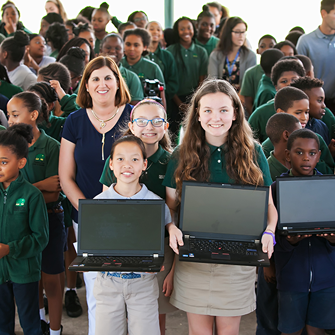
By now, most businesses are aware of the significant environmental impact of electronic waste, or e-waste. However, with the constant march of technological innovation, staying up-to-date with the latest recycling trends is crucial. In 2025, a new wave of technologies and certifications for managing electronic waste is set to emerge. In this article, we’ll explore current e-waste recycling trends, highlight what businesses need to know to adapt, and review the benefits of these practices.
Electronic waste, or e-waste, refers to any electronic device that is no longer in use. This includes computers, smartphones, tablets, gaming consoles, and more. E-waste is one of the fastest-growing waste streams globally, with over 50 million tons generated annually. In the U.S. alone, more than 400 million electronic items are discarded each year.
Due to growing concerns about e-waste’s environmental impact, many companies are now turning to e-waste management strategies to recycle outdated electronics properly. These efforts can also save businesses money by reusing materials from old devices instead of purchasing new ones.
Several global trends are shaping e-waste recycling practices:
As we approach 2025, new trends in e-waste recycling are poised to impact business practices significantly:
The future of e-waste recycling is bright, with emerging trends and technologies making the process more efficient and environmentally friendly. Businesses that adopt e-waste recycling practices not only help reduce the environmental impact of electronic waste but also gain several key advantages:
The world is changing, and so is the way we recycle electronics. In 2025, e-waste is expected to become an even more critical issue for businesses. To stay ahead, companies must embrace emerging recycling technologies and certifications that make the process as efficient and sustainable as possible.
By implementing e-waste recycling practices, businesses can reduce their environmental impact, save money, and enhance their sustainability credentials. Staying informed about trends and innovations ensures businesses remain competitive and responsible as the e-waste challenge continues to grow.
Embrace the change. Recycle responsibly. Build a sustainable future.
Fill out the form below to request your electronics recycling pickup.
We’ll coordinate the schedule logistics and follow up with next steps.
Yes, smart devices can help make offices more sustainable by reducing energy use, waste, and emissions. In this article, we explain how they do it — with real examples — and why it matters for those of us working toward more responsible technology (like we do at eSmart Recycling).
Smart devices include sensors, actuators, connected systems (IoT), automated LED lighting, HVAC control, environmental monitoring stations, and even furniture with sensors.
In short, they detect, measure, and adjust their operation according to what’s happening around them.
These devices can:
Integrating smart lighting and control systems can cut lighting-related electricity use by up to 30% compared to traditional systems.
According to the Association of Energy Engineers, automated buildings can reduce total energy consumption by 10–15%.
Occupancy sensors prevent lighting and HVAC systems from running in empty spaces. They also help extend the lifespan of electrical equipment by switching it off when not in use.
Monitoring CO₂ and humidity helps maintain cleaner air and more stable conditions, which can directly improve employee well-being and focus.
Smart systems collect data about usage patterns, energy consumption, and occupancy levels. With this data, organizations can:
A practical example: Vodafone’s headquarters in Paddington, London, uses IoT sensors to track desk usage, environmental conditions, and electricity consumption, integrating older systems for better control and visibility.
The Edge in Amsterdam is considered one of the most intelligent and sustainable buildings in the world. It has around 28,000 sensors that regulate lighting, air conditioning, and occupancy.
That level of control earned it a BREEAM rating of 98.4%.
Before installing sensors everywhere, conduct an energy audit to identify which systems consume the most and where improvements can be made.
Try a limited pilot — for example, meeting rooms or hallways — to measure results and fine-tune before scaling up.
Use platforms compatible with multiple vendors and IoT standards to avoid vendor lock-in.
Sensors need calibration and updates. Maintaining them ensures accurate data and long-term energy savings.
When devices reach the end of their life, that’s where we come in. At eSmart Recycling, we collect, audit, and recycle technology securely — keeping the cycle consistent and responsible.
How much does it cost?
The cost depends on the size and complexity of the system. Energy and operational savings often offset the initial investment within a few years.
Is it safe?
Yes, it’s safe — as long as best practices are followed: segmented networks, strong authentication, and data encryption.
Can it work in existing offices?
Yes, it can. Sensors and control modules can be added to existing lighting and HVAC systems.
Adopting smart devices isn’t just about cutting consumption or emissions — it’s about creating workspaces that are cleaner, more comfortable, and more conscious. At eSmart Recycling, we believe sustainability starts with everyday choices. A smarter office is one that uses technology to take care of both people and the planet.
Millions of electronic devices are produced every year, and a large portion of them end up as toxic waste. While there’s no official list that ranks the most polluting devices for the past twelve months, several studies highlight which ones cause the greatest environmental damage during production, use, or disposal.
We’re talking about devices that release large amounts of greenhouse gases, contain hazardous materials (like lead, cadmium, or brominated flame retardants), or end up in landfills where they leak harmful substances into the soil, water, or air.
Most of their environmental footprint comes from manufacturing—especially for devices with batteries or complex displays.
The total number of discarded units also plays a role: even a single gadget with a moderate footprint can cause massive environmental damage when millions are thrown away each year.
Their size is deceiving: manufacturing smartphones accounts for more than 80% of their total carbon emissions. Mining raw materials and assembling components create most of their environmental burden.
On top of that, frequent upgrades lead to constant disposal. According to the Global E-waste Monitor 2024, small IT and telecommunication equipment contribute millions of tons of electronic waste every year.
Computers generate significant emissions because of their batteries, circuit boards, and long-term electricity use. In life-cycle studies, manufacturing consistently represents the majority of its total footprint
Between 2014 and 2020, emissions linked to electronic waste rose by 53% in ICT devices.
Air conditioners, refrigerators, and microwaves contain gases and metals that, if not handled properly, can release powerful pollutants. In many countries, these items end up in landfills or informal recycling systems, causing environmental and health risks.
Sensors, smartwatches, electronic toys, and connected gadgets may have a small footprint individually, but together they represent a massive waste stream. The Global E-waste Monitor estimates that one-third of the world’s e-waste comes from these small devices.
At eSmart Recycling, we collect electronic equipment, securely destroy data, and give a second life to reusable devices. Every time a piece of tech is reused or recycled responsibly, we help reduce pollution and connect more people to digital access.
Every device has a story — from the moment its materials are extracted to its final use. Giving it a responsible ending can turn that same device into a bridge for education, communication, or opportunity.
Reusing and recycling technology isn’t just an environmental task; it’s a way to take care of the shared future we’re building together.
World Sustainability Day takes place on the last Wednesday of October, and in 2025, it feels more urgent than ever. It’s not just another awareness day — it’s a moment to pause, reflect, and act on what sustainability really means.
The signs are everywhere. In April 2025, the global average temperature rose 1.22°C above pre-industrial levels. Longer droughts, stronger storms, disappearing ecosystems — all of it is happening now.
At the same time, pressure on companies keeps growing. More states across the U.S. are making environmental reporting mandatory, demanding measurable actions and not just promises. Yet, some corporations have pulled back from publishing voluntary sustainability reports, even as public expectations for transparency are higher than ever.
That’s why this year, more than ever, it’s time to make noise with purpose.
Around 88% of consumers stay loyal to brands that stand for environmental or social causes. Using this day to communicate authentically builds connection — no corporate scripts, no fluff.
It’s not about promises. It’s about proof. Sharing both achievements and challenges earns respect. The best companies don’t just announce—they invite people to be part of the change.
Real change starts inside. A short talk, a “green audit,” or a small sustainability challenge can spark interest across teams and departments.
World Sustainability Day brings together NGOs, governments, and private companies. It’s a chance to build partnerships that go beyond a single event.
At eSmart Recycling, we live this every day. Collecting, refurbishing, and donating technology is how we contribute — helping protect the planet while bringing digital access to communities that need it most.
The time for speeches is over. What we do today matters.
This October 29, let’s make World Sustainability Day 2025 a day for real action, not just nice posts.
An old router may look like just another gadget collecting dust. But when recycled properly, it becomes a key piece in tackling environmental, social, and security challenges that affect us all. Both companies and households can play a part, starting with this device that often ends up forgotten in a drawer.
Every year, the world produces mountains of electronic waste. In 2022, the figure surpassed 62 million metric tons, and only about 22% was formally collected for recycling.
Routers, as small telecom devices, often slip through statistics and end up unmanaged. Giving them a proper end-of-life process keeps them out of informal dumps, where they contaminate for decades.
Producing a new router requires mining, energy-intensive manufacturing, transportation, and packaging. A McKinsey analysis shows that refurbishing broadband routers can cut emissions by 82% compared to making a new one.
For a company, recycling dozens of units means preventing tons of CO₂. For an individual, handing over just one device still avoids unnecessary duplication of resources.
Routers contain plastics, metals, flame retardants, and circuits with heavy metals. If dumped in landfills, they can leach into soil and water. When burned in informal processes, toxic gases directly affect nearby communities.
Certified recycling prevents this, ensuring hazardous components are isolated and treated under strict environmental standards.
Inside a router, there’s copper, aluminum, plastics, and small traces of precious metals. According to the UN, e-waste contains millions of tons of valuable resources that could be brought back into industry rather than extracted from new mines.
One router may feel minor, but thousands add up to sustained access to critical supply chains and less pressure on fragile ecosystems.
Even if boxed away, an old router may still store credentials, network settings, and logs. In the wrong hands, it’s an entry point to sensitive information.
For companies, this ties directly to compliance with regulations such as HIPAA. For households, it simply means keeping your home network safe. At eSmart Recycling, we make sure all devices are wiped or destroyed securely so no data is left behind.
Responsible recycling also fuels social initiatives. At eSmart Recycling, part of the equipment we collect is refurbished and donated to schools and nonprofits. A router that seemed obsolete can become a lifeline to online education for kids and families.
It also creates jobs in repair, logistics, and IT, while reducing the cost of managing uncontrolled e-waste at the community level.
Whether in a corporate office or at home, concrete steps with small devices like routers help reduce waste, cut emissions, protect privacy, and expand access to technology. At eSmart Recycling, we make sure that the process is handled safely and transparently.
In the next five years, we’ll see decisive changes in how companies, regulators, and consumers manage electronic waste. Cleaner technologies, stricter regulations, local supply chains, and stronger accountability from manufacturers are already on the horizon. Here’s what you need to know today to be ready for 2025–2030.
One of the biggest challenges is recovering rare earths, magnesium, and cobalt—many of which are lost because current processes are expensive or inefficient. Researchers at ETH Zurich have developed methods to extract elements like europium from fluorescent lamps more efficiently, with potential for large-scale use.
Apple also announced a partnership with MP Materials to recycle rare earth magnets in the U.S., with its Mountain Pass, California, facility expected to be fully operational by 2027.
Electric vehicle (EV) batteries that can no longer power cars often still have good capacity for stationary energy storage. Redwood Materials, for instance, is using old EV batteries to power data centers and storage systems.
This trend will reduce pressure on new mining and open dual business models: first mobility, then storage.
More U.S. states are expected to adopt laws requiring manufacturers to cover part of the cost of collection, recycling, and even design for recyclability. Signals of this shift are already showing in recent industry reports.
This will push companies toward modular design, safer materials, and recyclable packaging.
Recycling plants are adopting AI to improve material separation—using visual recognition and deep learning to distinguish plastics, metals, and electronic components. Companies like TOMRA are already deploying these systems.
Real-time monitoring with sensors and cameras will boost efficiency reports, material traceability, and transparency for regulators and partners.
The U.S. e-waste management market is projected to reach about USD 16.0 billion by 2025, with a compound annual growth rate of ~14.9% through 2034.
Globally, the electronics recycling market is expected to grow from ~USD 43.2 billion in 2025 to ~USD 147.9 billion in 2035, with a CAGR of ~13.1%.
But a large share of e-waste still never enters formal recycling: in 2022, only ~22% was properly recycled, and this rate may drop to ~20% by 2030 if nothing changes.
What’s clear is that tech recycling isn’t standing still. In the next five years, those who move quickly will gain a competitive edge, smoother compliance, a stronger reputation, and lower risks.
When a remote control stops working, the same thing usually happens: we buy another one from the same brand or grab a universal remote to fix the problem quickly. And the old one? It ends up in a drawer, forgotten with other devices we no longer use.
That small, everyday habit may seem harmless, but it hides a bigger issue. Every remote contains electronics, plastics, and batteries that should never end up in the trash. Disposed of the wrong way, they pollute. Recycled or refurbished, they can still be useful and prevent more resources from being wasted.
Every year, millions of tons of electronic waste (e-waste) are generated worldwide. In 2022, the world produced 62 million tons of e-waste, and only about 22% was formally collected and recycled.
Remote controls contain plastics, printed circuit boards, metals, and small batteries. When they end up in landfills, those batteries can leak toxic chemicals like lead, mercury, or cadmium, contaminating soil and water.
If the remote still works, it can be donated to schools, community centers, or electronics reuse programs. A simple gesture that extends the life of a device and helps people who don’t have easy access to technology.
Some stores accept remotes for recycling. For example, Best Buy includes “remote controls” in the list of electronics it collects.. On top of that, several U.S. states prohibit throwing electronics in regular trash.
Some brands already reuse components to make new remotes. Elisa Viihde reuses parts from returned remotes, and over 70% of its premium remotes include repurposed materials.
LG Chem manufactures remotes with post-consumer recycled plastics, reducing CO₂ emissions.
UEI (Universal Electronics Inc.) also uses recycled plastics and designs its devices to last longer.
| Question | Answer |
| What if the remote is broken? | Remove the batteries and take it to an e-waste collection site. Don’t throw it in regular trash. |
| Does recycling something so small really matter? | Yes. Multiply one remote by millions of households and you’ll see why it matters. Every recycled piece saves raw materials and prevents contamination. |
| Does it cost money to recycle? | Sometimes, but many stores and extended producer responsibility programs cover it, especially when you recycle along with other devices. |
At eSmart Recycling, we take care of the whole process: collecting electronics, auditing, securely destroying data, repairing, and donating devices. About 30% of our revenue goes directly into refurbishing and donating equipment to children and families.
A remote control may seem small, but it counts. If you keep it, donate it, or recycle it with us, you help reduce waste, save resources, and support communities.







If you want to know more about the different programs, partners, and overall cool things happening in the eSmart world, share your email with us, and Join the E-Revolution.